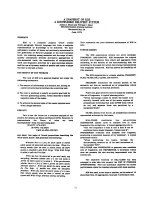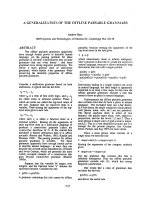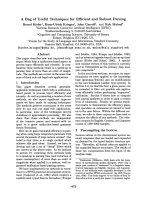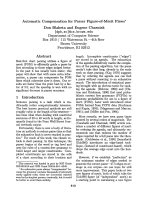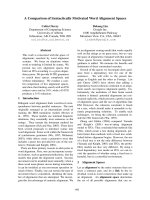Báo cáo khoa học: "A BASIS FOR A FORMALIZATION OF LINGUISTIC STYLE" pot
Bạn đang xem bản rút gọn của tài liệu. Xem và tải ngay bản đầy đủ của tài liệu tại đây (299.13 KB, 3 trang )
A BASIS FOR A FORMALIZATION OF LINGUISTIC STYLE
Stephen J. Green
Department of Computer Science
University of Waterloo
Waterloo, Ontario, Canada N2L 3G1
INTRODUCTION
Style in language is more than just surface ap-
peaxance, on the contrary, it is an essential part
of the meaning conveyed by the writer. A
com-
putational theory of style
could be of great use
in many computational linguistics applications. A
system that is 'stylistically aware' could analyze the
writer's stylistic intent and understand the com-
plex interaction of choices that produce a certain
effect. In applications such as machine translation,
a computational theory of stylistics would allow
the preservation or modification of stylistic effects
across languages. The theory would also be use-
ful in computer-aided language instruction where,
along with vocabulary and grammar, the individ-
ual writing style of the student could be analysed
and amended. The work described in this paper
will be incorporated into into the Nigel grammar
of the Penman system to provide a fine degree of
stylistic control in language generation.
Drawing on both classical and contemporary
rhetorical theory, we view style as
goal directed:
that is, texts axe written for a purpose and this
purpose dictates the stylistic choices that must be
made. We find a computational counterpart to this
view in the work of Hovy (1988), who used style as
one of the pragmatic factors controlling generation
in his PAULINE system. More recently, DiMaxco
(1990), the basis for this research, attempted to
codify many of the elements of style that had pre-
viously been defined only descriptively and infor-
mally.
DiMaxco presented a vocabulary of stylistic
terms that was used to construct a
syntactic stylis-
tic grammar
at three levels:
primitive elements, ab-
stract elements,
and
stylistic goals.
At the base
level of the grammar, the primitive elements de-
scribe the stylistic effects of individual sentence
components. These primitive elements axe then
combined at a level of more abstract descriptions.
These abstract elements comprise a stylistic 'met-
alanguage' that allows each element to be used
to characterize a gIoup of stylistically similar sen-
tences. At the top level are the stylistic goals, such
as clarity or concreteness, that are realized by pat-
terns of the abstract elements.
312
The primitive-element level of DiMaxco's
stylistic grammar is divided into two views,
connec-
tire and hierarchic.
Here I will focus on the connec-
tive view, for which the stylistic effect of a sentence
component is determined by considering its degree
of
cohesiveness
within the sentence. The degrees of
cohesiveness, or
connectivity,
vary on a scale from
conjunct °
(neither connective nor disconnective)
through
conjunct 4
(excessively connective). 1
In more recent work, DiMaxco and Hirst (1992)
have provided a more formal basis for their the-
ory of linguistic style, a basis that has its roots
in the established linguistic theory of Halliday and
Hasan (1976) and Halliday (1985). I am extend-
ing and refining their preliminary classifications of
the primitive elements to provide a sounder basis
for the entire computational theory of style. I will
show how the connective primitive elements can
be firmly tied to linguistic theory and how their
properties are transmitted through the levels of the
stylistic grammar.
A BASIS FOR LINGUISTIC STYLE
Drawing on the work of Halliday and Hasan (1976),
a seminal work in textual cohesion, I will show how
intrasentence cohesion, and its related stylistic ef-
fects, can be derived from the textual cohesive rela-
tions that Halliday and Hasan describe. Although
there are undoubtedly significant stylistic effects at
the text level, I feel that the codification of style at
the sentence level has not yet been fully explored.
For the most part, these cohesive relations func-
tion as well at the sentence level as they do at the
text level. This is illustrated in Quirk et
al.
(1985),
where all of the relations that Halliday and Hasan
describe for texts are also demonstrated within sin-
gle sentences.
Halliday and Hasan enumerate four major
types of cohesive relations for English:
ellipsis, sub-
stitution, reference,
and
conjunction.
They classify
IThere is also a scale of disconnectivity, or 'anti-
junctness', but I will not be using it in this discussion.
these relations in terms of their cohesive strengths
relative to one another: ellipsis and substitution axe
the most cohesive relations, followed by reference,
with conjunction being the least cohesive. One of
the main objectives of my research is determining
how all of these cohesive relations can be incorpo-
rated into the scale of 'conjunctness' described ear-
lier. In this paper, I will deal only with ellipsis. 2
Halliday and Hasan consider substitution to be
equally as cohesive as ellipsis. I argue that el-
lipsis is more cohesive, after Quirk
etal.
(1985,
p. 859) who state that for substitution and ellip-
sis "there are generally strong preferences for the
most economical variant,
viz
the one which exhibits
the greatest degree of reduction." Thus, the ellip-
tical relations are more cohesive, due to the fact
that they are generally more reduced. In DiMaxco
and Hirst, all forms of eRipsis are given a classifica-
tion of
conjunct s
(strongly connective), but here I
will look at the three types of ellipsis separately, as-
signing each its own degree of cohesiveness, s This
assignment is made using by considering the most
reducing
relations to be the most cohesive, in the
spirit of the above quote from Quirk
et al.
Since
Halliday and Hasan provide a ranking for the four
types of cohesive relation, and since ellipsis is con-
sidered to be the most cohesive relation, all of the
degrees assigned for the different types of ellipsis
will be ranked in the top half of the scale of cohe-
siveness.
The first type of ellipsis which Halliday and
Hasan deal with is
nominal ellipsis.
This occurs
most often when a common noun is elided from
a nominal group and some other element of the
nominal group takes the place of this elided noun.
An example of this occurs in (1), where the noun
ezpedition
is elided, and the numerative t~0o takes
its place.
(1) The first expedition was quickly followed by
another two Q.4
This is the least concise form of ellipsis, since only
a single noun is elided. As such, it is given the
lowest classification in this category:
conjunct s
(moderately-strong connective).
Next, we have
verbal ellipsis.
In instances of
verbal ellipsis, any of the operators in the verbal
group may be elided, as opposed to nominal ellipsis
aWhen identifying the kinds of ellipsis, I use the
texans defined by Halliday and Hasan and Quirk
etal.
All examples are taken from the appropriate sections
of these references.
sI will be using a
wider scale of cohesiveness than
the one used by DLMarco and Hirst. Here
conjunc~ e,
rather than
conjunct*,
becomes the classification for
the excessively connective. This change is made to al-
low for the description of more-subtle stylistic effects
than is currently possible.
4Adapted from Quirk
etal.
example 12.54, p. 900.
where only the noun is elided. As Halliday and
Hasan point out, many
forms
of verbal ellipsis are
very diiticnlt to detect, due to the complexity of the
English verbal group. Because of this, I will deal
only with two simple cases of verbal ellipsis: those
in which the verbal group is removed entirely, as in
(2), and those in which the verbal group consists
of only modal operators, as in (3).
(2) You will speak to whoever I tell you to Q.5
(3) It may come or it may not ®.e
Both of these sentences axe quite concise, as all,
or nearly all, of the verbal group is elided. Verbal
ellipsis is generally more concise than nominal el-
lipsis, and thus it has a higher level of cohesiveness:
conjunct 4.
Finally, we look at
clausal ellipsis,
in which an
entire clause is elided from a sentence. We see an
example of this in (4).
(4) You can borrow my pen if you want Q.7
Since this form is more concise than either of the
previous two verbal forms, we accord it a still
higher level of cohesiveness:
conjunct s.
This clas-
sification gives clausal ellipsis a degree of cohesive-
ness verging on the extreme. The excessive amount
of missing information tends to become conspicu-
ous by its absence. Here we axe beginning to devi-
ate from what would be considered normal usage,
creating an effect that DiMaxco (1990) would call
st~/listic discord.
I will now present a short example to demon-
strate how the effects of a foundation based on
functional theory axe built up through the three
levels of the stylistic grammar.
313
A SIMPLE EXAMPLE
I will use the functional basis of style described
above to illustrate how small variations in sen-
tence structure can lead to larger variations in the
stylistic goals of a sentence. This will be demon-
strated by tracing the analysis of an example sen-
tence through the levels of description of the stylis-
tic grammar.
The first step in the analysis determines which
connective primitive elements axe present in the
sentence and where they occur in our scale of co-
hesiveness. Next, the primitive elements axe used
to determine which abstract elements axe present.
Finally the abstract elements axe examined to de-
termine the stylistic goals of the sentence.
We start with sentence (4) as above. This
sentence contains several connective primitive d-
ements, the most prominent being the
conjunct s
SQuirk et al. example 12.64, p. 908.
eAdapted from Halliday and Hasan example 4:57,
p. 170.
~Quisk etal. example 12.65, p. 909.
clausal ellipsis noted eaxlier, as well as instances of
a conjunct a personal reference (you), a conjunct 2
deictic (my), and a conjunct 1 adversative (if you
want). (Although I have completed the analysis for
the other cohesive relations, here I am using the
preliminary classifications given by DiMaxco and
Hirst (1992) for the other connective elements.)
Apart from the terminal ellipsis, all of these
connective elements are concordant, that is, they
represent constructions that conform to normal us-
age. The terminal ellipsis, due to its excessively
high level of cohesiveness, is weakly discordant, a
slight deviation from normal usage. Thus, this sen-
tence contains initial and medial concords, followed
by a terminal discord. In the terms of the stylis-
tic grammar, this shift from concord to discord is
formalized in the abstract element of dissolution.
The presence of dissolution characterizes the stylis-
tic goal of concreteness, which is associated with
sentences that suggest an effect of specificity by an
emphasis on certain components of a sentence. In
this sentence, the emphasis is created by the ter-
minal discord. The clausal ellipsis requires that a
great deal of information be recovered by the reader
and because of this it leaves her feeling that the
sentence is unfinished.
The next example, sentence (5), is a modifica-
tion of (4) and is an example of verbal ellipsis, as
in (2).
(5) You can borrow my pen if you want to Q.
In this sentence, all of the previous connective el-
ements remain except for the terminal clausal el-
lipsis. This ellipsis has been replaced by a ver-
bal ellipsis that is conjunct 4, strongly but not ex-
cessively cohesive. This replacement consequently
eliminates the terminal discord present in the pre-
vious sentence, changing it to a strong concord.
Thus, (5) has initial, medial, and terminal con-
cords, making it a fully concordant sentence. At
the level of abstract elements, such a sentence is
said to be centroschematic, that is, a sentence with
a central, dominant clause with optional depen-
dent clauses and complex subordination. Cen-
troschematic sentences characterize the stylistic
goal of clarity, which is associated with sentences
that suggest plainness, preciseness, and predictabil-
ity. In this sentence, the effect of predictability is
created by removing the terminal discord, thus re-
solving the unfulfilled expectations of (4).
Thus, using the cohesive relations of Halliday
and Hasan, it is possible, as I have shown, to pro-
vide a formal basis for the connective primitive el-
ements of the syntactic stylistic grammar. These
primitive elements can now be used as the compo-
nents of more-precise abstract elements, with sub-
tle variations in the primitive elements allowing
more-expressive variations in the abstract elements
314
that constitute a sentence. These variations at the
abstract-element level of the grammar axe mirrored
at the level of stylistic goals by large variations in
the overall goals attributed to a sentence.
CONCLUSION
The research presented above is a part of a larger
group project on the theory and applications of
computational stylistics. I have completed the in-
tegration of all the connective primitive elements
with Halliday and Hasan's theory of cohesion. My
next step is to perform the same kind of analysis
for the hierarchic primitive elements, giving them a
solid basis in functional theory. In addition, I have
completed refinements to the abstract elements,
making them more expressive, and I will be able
to formulate their definitions in terms of the new
primitive elements.
The full theory of style will be implemented in
a functionally-based stylistic analyzer by Pat Hoyt.
This control of stylistic analysis combined with my
work on the Penman generation system will allow
us to begin exploring the myriad of applications
that require an understanding of the subtle but sig-
nificant nuances of language.
ACKNOWLEDGMENTS
This work was supported by the University of
Waterloo and the Information Technology Re-
seaxch Centres. My thanks to Chyrsanne DiMaxco,
Gracme Hirst, and Cameron Shelley for their com-
ments on an earlier version of this paper, and to the
Anonymous Referees for their helpful criticisms.
REFERENCES
DiMaxco, Chrysanne (1990). Computational stylis-
tics for natural language translation. PhD the-
sis, University of Toronto.
DiMaxco, Chrysanne and Hirst, Graeme (1992).
"A computational approach to style in lan-
guage." Manuscript submitted for publication.
Halliday, Michael (1985). An introduction to func-
tional grammar. Edward Arnold.
Halliday, Michael and Hasan, Ruqaiya (1976) Co-
hesion in English. Longman.
Hovy, Eduaxd H. (1988). Generating natural lan-
guage under pragmatic constraints. Lawrence
Edbaum Associates.
Quirk, Randolph, Greenbaum, Sidney, Leech, Ge-
offrey, and Svartvik, Jan (1985). A comprehen-
sive grammar of the English language. Long-
man.





